- News
- Reviews
- Bikes
- Accessories
- Accessories - misc
- Computer mounts
- Bags
- Bar ends
- Bike bags & cases
- Bottle cages
- Bottles
- Cameras
- Car racks
- Child seats
- Computers
- Glasses
- GPS units
- Helmets
- Lights - front
- Lights - rear
- Lights - sets
- Locks
- Mirrors
- Mudguards
- Racks
- Pumps & CO2 inflators
- Puncture kits
- Reflectives
- Smart watches
- Stands and racks
- Trailers
- Clothing
- Components
- Bar tape & grips
- Bottom brackets
- Brake & gear cables
- Brake & STI levers
- Brake pads & spares
- Brakes
- Cassettes & freewheels
- Chains
- Chainsets & chainrings
- Derailleurs - front
- Derailleurs - rear
- Forks
- Gear levers & shifters
- Groupsets
- Handlebars & extensions
- Headsets
- Hubs
- Inner tubes
- Pedals
- Quick releases & skewers
- Saddles
- Seatposts
- Stems
- Wheels
- Tyres
- Health, fitness and nutrition
- Tools and workshop
- Miscellaneous
- Buyers Guides
- Features
- Forum
- Recommends
- Podcast
review
£2,199.00
VERDICT:
Fast and comfortable 1x11 all-season road bike at a competitive price
Weight:
9,250g
Contact:
At road.cc every product is thoroughly tested for as long as it takes to get a proper insight into how well it works. Our reviewers are experienced cyclists that we trust to be objective. While we strive to ensure that opinions expressed are backed up by facts, reviews are by their nature an informed opinion, not a definitive verdict. We don't intentionally try to break anything (except locks) but we do try to look for weak points in any design. The overall score is not just an average of the other scores: it reflects both a product's function and value – with value determined by how a product compares with items of similar spec, quality, and price.
What the road.cc scores meanGood scores are more common than bad, because fortunately good products are more common than bad.
- Exceptional
- Excellent
- Very Good
- Good
- Quite good
- Average
- Not so good
- Poor
- Bad
- Appalling
Take a look at British company Whyte's mountain bike range and you won't find any front mechs. It's a firm believer in 1x11 drivetrains. Now, it has applied this same philosophy to the Wessex One and in doing so created a fast and comfortable endurance bike with lots of practical details. The easy and simple 1x11 gear shifting has all the range needed for tackling hills and flat roads. It's a really good all-season bike at a very good price.
- Pros: Fast, comfortable, easy to use gears, wide range gears, mudguards, looks fab
- Cons: Not light, gearing won't suit everyone
> Find your nearest dealer here
I tested the Wessex when it first launched a couple of years ago, and found it to be a really smartly designed road bike that brought together a lot of trends then emerging in the road bike market – wide tubeless tyres on wide rims, disc brakes, endurance geometry, optional mudguards – and combined them into a very cohesive package. And now there is another new trend to add to that list: 1x11.
What the 1x is that?
To quickly recap in case you've not been paying attention, 1x11 comprises a groupset with a single chainring up front and a wide-range 11-speed cassette out back. Chain retention in lieu of the front mech is taken care of by specially shaped thick/thin chainring teeth and a clutch-style rear mech.
Such a setup is hugely popular on mountain bikes where the increased simplicity and mud/tyre/pivot clearance are notable benefits. The technology, like many ideas first developed for our fat-tyred cousins, is starting to find its way onto road bikes. There was the 3T Strada I reviewed at the end of last year, and a long list of gravel, adventure and cyclo-cross bikes that all had the lack of a front mech in common.
If you're worried that such a setup will mean a struggle on the hills or lack of top-end on the flat road, fear not, the Wessex One's 10-42t cassette and 44t chainring provided ample range for all the riding situations I found myself in. And just like a regular groupset, the gearing can be altered by swapping the chainring for one of a different size. But I found the stock setup just fine for my local roads and style of riding.
From faster-paced group rides to hilly romps over the Cotswolds escarpment, there was never a time when I found myself running out of gears. It's low enough for grinding up steep ascents, high enough for making the most of a tailwind. It simply works well all of the time.
Granted, the gaps between some of the gears are a little larger than a regular double chainset groupset, but they don't make nearly the impact you'd imagine in real-world riding. And I'm not talking about racing here, but riding regular speeds over undulating terrain.
I never found myself failing to find a gear to suit my preferred cadence, whether on the climbs or on the flats. Unless you absolutely have to be bob on 95rpm all the time, most people, myself included, vary cadence depending on the specific situation and can deal with a slightly higher or lower pedalling rate.
For people who bang on about being in the ideal cadence all of the time as one of the reasons why 1x will never catch on, well unless you're running a corncob straight-up cassette, you're facing jumps between the sprockets even with a conventional groupset. With the increasing popularity of wide-range cassettes – 11-30 and 11-32 for example – you're looking at bigger gaps between the sprockets even on a regular bike.
But the other key detail about a 1x11 groupset that is often forgotten is that there's no duplication of gear ratios. A regular 22-speed groupset actually only provides 13 individual gear ratios once you remove the duplicated gears. So you're not really losing out by taking off the front mech and one of the chainrings.
Read more: Is the front mech dead?
The other nice thing about 1x11 is that you don't need a compensation shift when you change from one chainring to another. Like when you're coming into the bottom of a gradually steepening climb: instead of shifting from the big to the little chainring (always with the risk of dropping the chain) and then shifting up one, two or three sprockets at the back to maintain your preferred cadence, on the Whyte you simply shift the lever left to switch to an easier gear as and when you need it. It's simple and it does work.
For sure 1x11 won't be for everyone, and Whyte still offers a regular version of the Wessex if you prefer that setup. However, I'm of the opinion that for a lot of the cyclists this bike is aimed at and the sort of riding it's intended for, the simplified groupset offers a tangible benefit with few downsides.
Ride and handling
With the groupset taken care of, let's now turn our attention to how the bike rides. As I found with the original Wessex, the ride is both fast and stable, thanks to the stiff carbon fibre frame and fork and the geometry, which is longer and slacker than a race bike. It provides fast and flighty performance when you spin the cranks up, yet there's adequate comfort from the 30mm tyres to ensure you're not going to be battered and left all achy after a couple of hours tackling ruinously potholed and cracked UK roads.
Geometry goes a long way to defining how a bike rides, and the longer wheelbase and slacker head angle when compared to a race bike gift the Wessex the sort of surefooted handling you want for those long distance rides over a wide variety of road surfaces.
> Buyer's Guide: 10 of the best mudguard-compatible carbon fibre road bikes
Whyte has never made a race bike and probably never will, so it's not restricted by what pros or the UCI demand, which gives it the freedom to design a bike it believes works well for non-racing British cyclists. So the steering is nicely weighted with just the right turning speed. It's not too zippy but neither is it sluggish, letting you seek thrills in the bends if you want to have some fun. It's also stable at higher speeds and on rough roads when you want to relax and enjoy the view or conversation.
It feels at home on UK roads and I felt right at home on it; it was a great partnership.
Frame design
The frame and fork are essentially the same as the regular Wessex, except for the lack of a front mech clamp. This 1x focus gives the frame a very clean appearance and is a damn sight nicer than the blanking plates I've seen covering up redundant clamps on a number of gravel and adventure bikes.
It's a sleek and streamlined looking frame, but it hasn't been shaped in a wind tunnel, though the fast looks are backed up a very rapid turn of speed. It's a swift endurance bike that will suit those of you who might normally ride a race bike but recognise you could benefit from a bit more comfort and practicality for UK roads and conditions.
A longer fork length – the same axle-to-crown length as a cyclo-cross fork – means Whyte has been able to keep the head tube shorter to provide the desired stack height without the need for a stack of headset spacers.
The 27.2mm seatpost and skinny seatstays help to provide reasonable seated comfort but it's not quite as vibration-absorbing as the Cannondale Synapse or Specialized Roubaix. I'm talking a small shade of difference, though, and for the most part the Wessex does a fine job of coping with the roughest surfaced roads I could find.
All cables and brakes hoses are internally routed so it's all very clean, 12mm thru-axles clamp both wheels securely into place, and there's the latest flat mount standard for attaching brake callipers.
A neat detail is the hidden seat clamp, though it's easily accessed by lifting up the rubber flap that also wraps around the seatpost to prevent water getting into the frame.
An externally threaded bottom bracket instead of press-fit provides peace of mind, with easy servicing and bearing changes for a component that is susceptible to the conditions.
Naturally, a bike designed for UK cycling needs to accept mudguards, and the Wessex One does. These optional mudguards are Whyte's own design and fit the frame and fork very nicely.
Strip the mudguards away and there's space for up to 35mm tyres, or 30mm with the mudguards fitted. You could conceivably fit wider gravel tyres if you want to give the bike a little more mixed terrain capability, though it's designed primarily as a road bike. Whyte offers dedicated gravel and adventure bikes if you want to really get off the tarmac into the woods and trails.
Build and equipment
SRAM is really leading the 1x charge and its Apex groupset is its most affordable offering, but it gets all the key tech of its more expensive Force groupset. So the brakes are hydraulic with good lever feel and plenty of power from the 160mm front and rear brake discs, making one-finger braking perfectly possible, and the mechanical gear changes from the single DoubleTap shift lever are light and crisp.
The 23mm wide WTB Asym i23 rims were originally designed for mountain biking, but would be considered too narrow for mountain biking by today's standards. With road bike rims getting wider to suit wider tyres, they are actually a good choice for a road bike. They're tubeless-ready, with 28 spokes in each wheel in an asymmetrical design to better distribute spoke tension, and are strong and durable. The test bike was supplied with tubeless valves and sealant installed, and I had no issues during the test period with punctures or air loss.
Hubs are Whyte's own aluminium design with double sealed cartridge bearings and an XD Driver freehub, necessary to accommodate the 10-42t cassette. The hubs caused no issues during testing, but this definitely wasn't a year-long test that would be needed to really assess hub reliability.
Whyte fits the bike with its own aluminium stem, compact wing-shaped handlebar, seatpost and saddle. It's all nice looking kit, if plain and understated, and works perfectly fine. The saddle, in particular, is a good shape for me, with generous padding. I also liked the shape of the handlebar, with easy-to-reach drops and comfortable tops. The stem lengths are size-specific but I swapped to a 120mm stem to get the perfect reach to the bar.
The WTB Exposure tyre is a good choice, providing good rolling resistance and reliable grip in a range of weather conditions. Mounted to wide rims, the tyres actually come up a little wider, and run at lower pressures there's good sidewall support for rock-solid cornering stability. Tubeless adds a lovely safety net when the local farmer has decided that the morning of your ride is a good time to trim the hedgerows.
As I mentioned above, the Wessex One I tested was fitted with the optional mudguards that Whyte has designed for this bike. They provide good wheel coverage, keeping the majority of wheel spray off your bum, back, feet and shins, and didn't rattle or squeak. You could easily remove the mudguards for summer use, with the concealed mounts leaving no ugly trace of the bike's mudguard compatibility.
At 9.25kg the Wessex One is not going to win any weight weenie awards, but it's on the cusp of acceptability for a bike of this specification and price. The mudguards add weight so you could trim it for summer use by pulling them off, and get it closer to the claimed 8.8kg weight. But the focus here is on solid and dependable kit that isn't going to fail on you when you're 50 miles from home. It's built to last.
Conclusion
The Whyte Wessex One is ideally suited for tackling the four-seasons (or is it one?) of the UK, with a fast turn of speed for summer sportives and long-distance comfort for long winter training rides. I'm in no doubt that the 1x gearing, while not better than 2x as such, is a viable alternative if you prefer a simpler setup with easy shifting and all the gear range you need to cope with most terrain the UK can serve up.
Add to the mix the wide tubeless tyres, mudguards, hydraulic disc brakes, comfortable contact points and a keen price, and the Whyte Wessex One is worth adding to your shortlist. I even love the bright yellow paint job.
Verdict
Fast and comfortable 1x11 all-season road bike at a competitive price
road.cc test report
Make and model: Whyte Wessex One
Size tested: 54cm
About the bike
State the frame and fork material and method of construction. List the components used to build up the bike.
Frame - Uni-directional Multi Monocoque, One-By Specific, with Flat Mount 160 Disc Mount, DOX Internal Cable Routing, Verti-Grip Integrated Seat Clamp System, Concealed Eyelets for Mud Guards and 142mm Rear Dropouts with 12mm Through Axle
Cable Routing - Internal
Fork - Straight Bladed Carbon Front Fork, Tapered Carbon Steerer with 12mm x 100mm Stealth Through Axle, Concealed Eyelets for Mud Guards
Stem - Whyte -6 Deg/6 Deg, 90mm 50cm, 100mm 52cm, 110mm 54cm, 120mm 56/58cm
Handlebars - Whyte Road, 31.8mm, Compact "Wing" Bar
Brakes Calipers - SRAM Force 1 Hydraulic, 160mm Flat Mount, Internal Routing
Brake / Gear Lever - SRAM APEX 1, Full Hydraulic, 11 Speed
Front Hub - Alloy, Double Sealed Cartridge Bearing Hub, 12mm x 100mm Through Axle, 28 Hole
Rear Hub - Alloy, Double Sealed Cartridge Bearing Hub, 12mm x 142mm Through Axle, 28 Hole, XD Driver
Rims - WTB Asym i23, 23mm TCS System, 28 Hole
Tyres - WTB Exposure, 700 x 30c, TCS System, Distance Compound
Rear Derailleur - SRAM APEX 1, Long Cage, 11 Speed
Chainset - SRAM APEX 1, X-SYNC 44T Chainring
Cassette - SRAM PG-1150, 10-42, 11 Speed
Saddle - Whyte Custom Road, with Lightweight Foam, CrMo Rails, Triple Panel Design
Seatpost - Whyte 20mm Offset, 27.2mm x 350mm, 1pcs 3d Forged 2014 Alloy, 2 Bolt Clamp
Tell us what the bike is for
Whyte says, "A collection of components is useless without the frame to match though, so in the words of our former Elite, UCI ranked road racing designer Ian, we've created the ultimate '21st century British road bike.' Light, aerodynamic and precise steering for searing speed, but with the rear stay and 27.2mm seat post compliance to fight fatigue all day. Naturally it's got ample clearances for large volume tyres and all the weather sealed, non frame-rubbing DOX internal cable routing wisdom of our MTBs. We've even designed our own flush-fit mudguards because you're never far from rain even in July and we know this is a bike you'll want to ride every day for sportives, Strava, fitness or just because serious performance is seriously fun."
Frame and fork
Overall rating for frame and fork
8/10
Tell us about the build quality and finish of the frame and fork?
Very high quality.
Tell us about the materials used in the frame and fork?
Full unidirectional carbon fibre frame and fork.
Tell us about the geometry of the frame and fork?
More relaxed than a race bike for long distance stability and comfort.
How was the bike in terms of height and reach? How did it compare to other bikes of the same stated size?
With a 120mm stem the bike fitted me really well.
Riding the bike
Was the bike comfortable to ride? Tell us how you felt about the ride quality.
With 30mm tyres, skinny stays and a 27.2mm seatpost it's a comfortable ride over rough roads.
Did the bike feel stiff in the right places? Did any part of the bike feel too stiff or too flexible?
That oversized down tube and chainstays ensure there's adequate stiffness when you want to give it the beans.
How did the bike transfer power? Did it feel efficient?
Very well.
Was there any toe-clip overlap with the front wheel? If so
None.
How would you describe the steering? Was it lively Just right
Tell us some more about the handling. How did the bike feel overall? Did it do particular things well or badly?
Very easy handling at a range of speeds, stable at higher speeds.
Which components had the most effect (good or bad) on the bike's comfort? would you recommend any changes?
I enjoyed using the Apex 1x11 groupset with the solid hydraulic disc brakes.
Which components had the most effect (good or bad) on the bike's stiffness? would you recommend any changes?
There's nothing I'd immediately want to change.
Which components had the most effect (good or bad) on the bike's efficiency? would you recommend any changes?
No changes.
Rate the bike for efficiency of power transfer:
7/10
Rate the bike for acceleration:
7/10
Rate the bike for sprinting:
7/10
Rate the bike for high speed stability:
8/10
Rate the bike for cruising speed stability:
8/10
Rate the bike for low speed stability:
7/10
Rate the bike for flat cornering:
7/10
Rate the bike for cornering on descents:
8/10
Rate the bike for climbing:
6/10
The drivetrain
Rate the drivetrain for performance:
7/10
Rate the drivetrain for durability:
7/10
Rate the drivetrain for weight:
6/10
Rate the drivetrain for value:
7/10
Wheels and tyres
Rate the wheels for performance:
7/10
Rate the wheels for durability:
7/10
Rate the wheels for weight:
6/10
Rate the wheels for comfort:
8/10
Rate the wheels for value:
7/10
Rate the tyres for performance:
9/10
Rate the tyres for durability:
8/10
Rate the tyres for weight:
6/10
Rate the tyres for comfort:
8/10
Rate the tyres for value:
7/10
Controls
Rate the controls for performance:
7/10
Rate the controls for durability:
7/10
Rate the controls for weight:
6/10
Rate the controls for comfort:
8/10
Rate the controls for value:
7/10
Your summary
Did you enjoy riding the bike? Yes
Would you consider buying the bike? Yes
Would you recommend the bike to a friend? Yes
Rate the bike overall for performance:
8/10
Rate the bike overall for value:
8/10
Use this box to explain your overall score
It's a really good four-season British designed bike that funnily enough works very well on British roads and in British conditions.
About the tester
Age: 31
I usually ride: My best bike is:
I've been riding for: 10-20 years I ride: Every day I would class myself as: Expert
I regularly do the following types of riding: road racing, time trialling, cyclo cross, commuting, touring, mountain biking
David worked on the road.cc tech team from 2012-2020. Previously he was editor of Bikemagic.com and before that staff writer at RCUK. He's a seasoned cyclist of all disciplines, from road to mountain biking, touring to cyclo-cross, he only wishes he had time to ride them all. He's mildly competitive, though he'll never admit it, and is a frequent road racer but is too lazy to do really well. He currently resides in the Cotswolds, and you can now find him over on his own YouTube channel David Arthur - Just Ride Bikes.
Latest Comments
- Chris RideFar 5 hours 47 min ago
I know that in independent tests on 10 and 11 speed chains, the SRAM chains always came out bottom in terms of drivetrain efficiency. Lots of...
- quiff 5 hours 53 min ago
The comparison was between two things never intended to be used on a bike.
- perce 6 hours 23 min ago
You could get knocked down at midnight and the jury would believe a driver who said the sun was in his eyes.
- Simon E 6 hours 39 min ago
We'll have to disagree. It's as ugly as f..k. You can try putting lipstick on a pig but it's always going to be a pig....
- chrisonabike 7 hours 11 min ago
Well, send us a review when you've cycled it!...
- KDee 8 hours 13 sec ago
Funnily enough, my experience with Wahoo TCKR is that when that needed a new battery, it would also go in the bin. The battery locating tabs would...
- Backladder 8 hours 33 min ago
Since the driver used similar language it in not "likely" that he was caused harrasment alarm or distress by having it returned to him. (IANAL)
- underworld99 12 hours 24 min ago
Some more local knowledge :...
- eburtthebike 13 hours 40 min ago
“There is a road safety emergency in our region. As Mayor, I’m committed to tackling this issue."...













































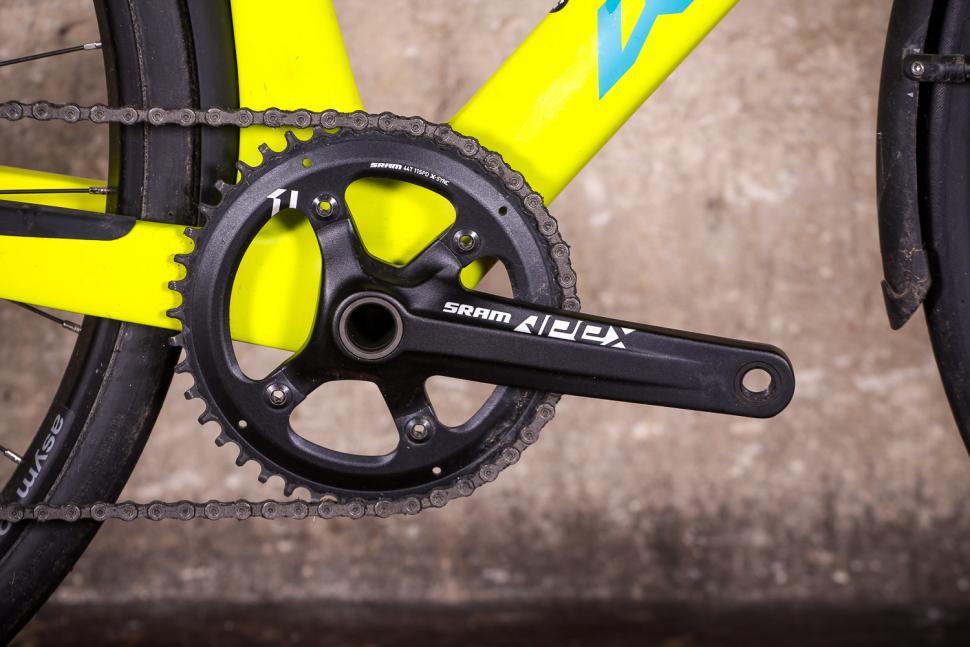
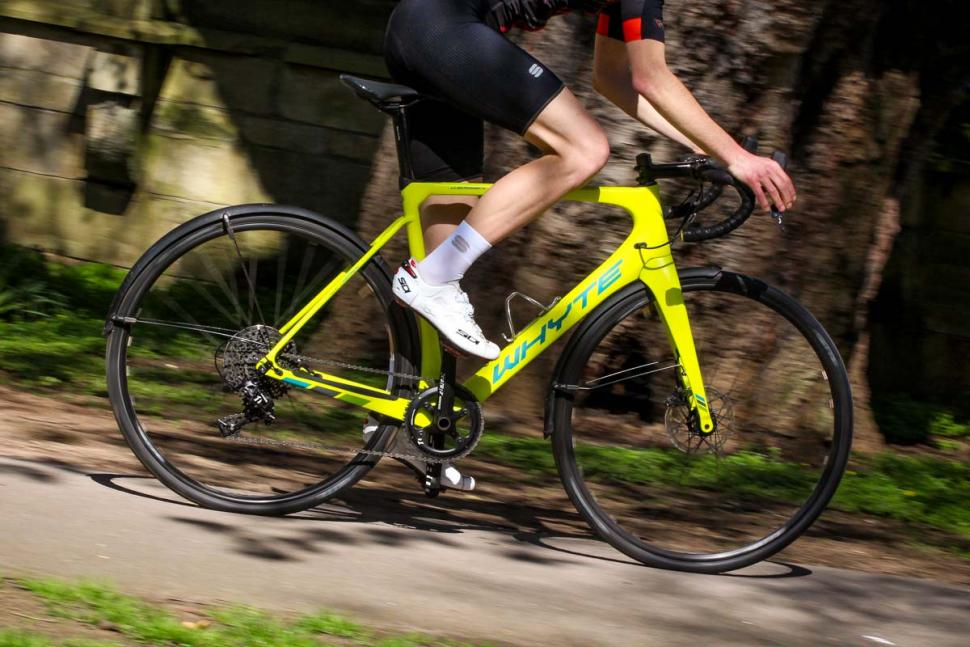

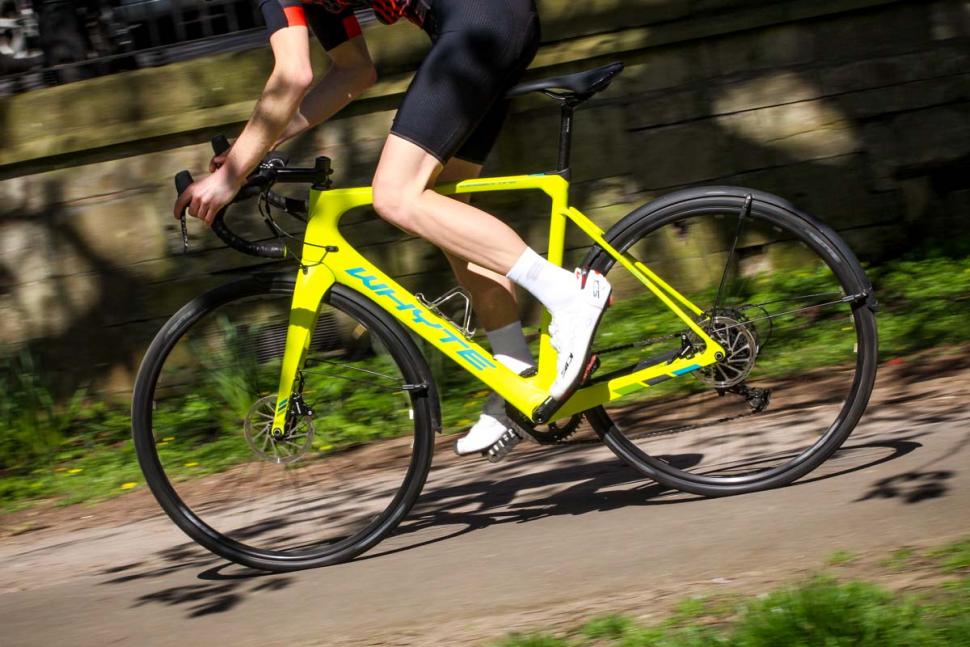
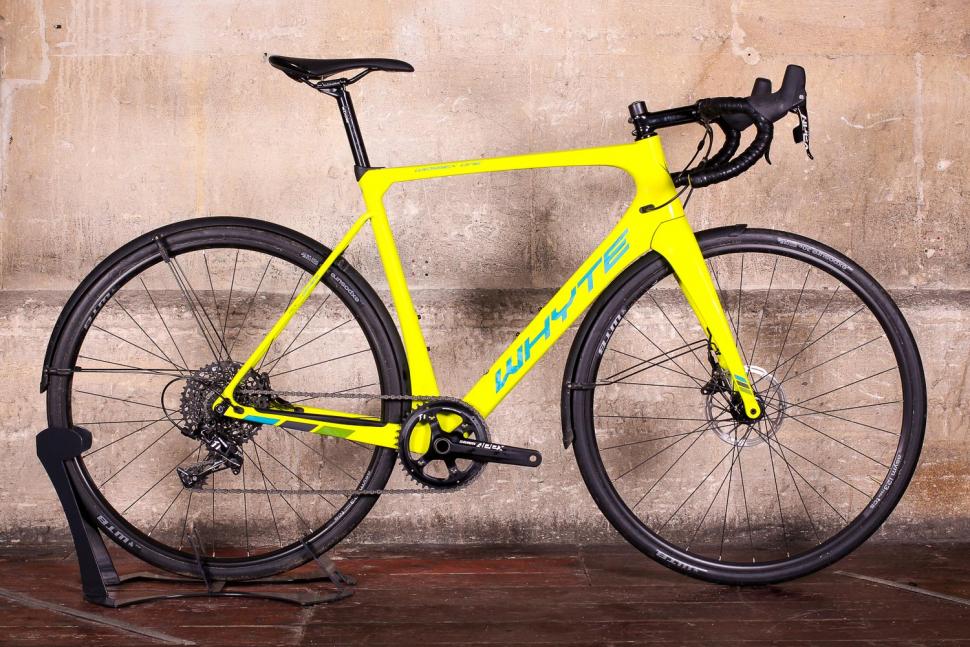
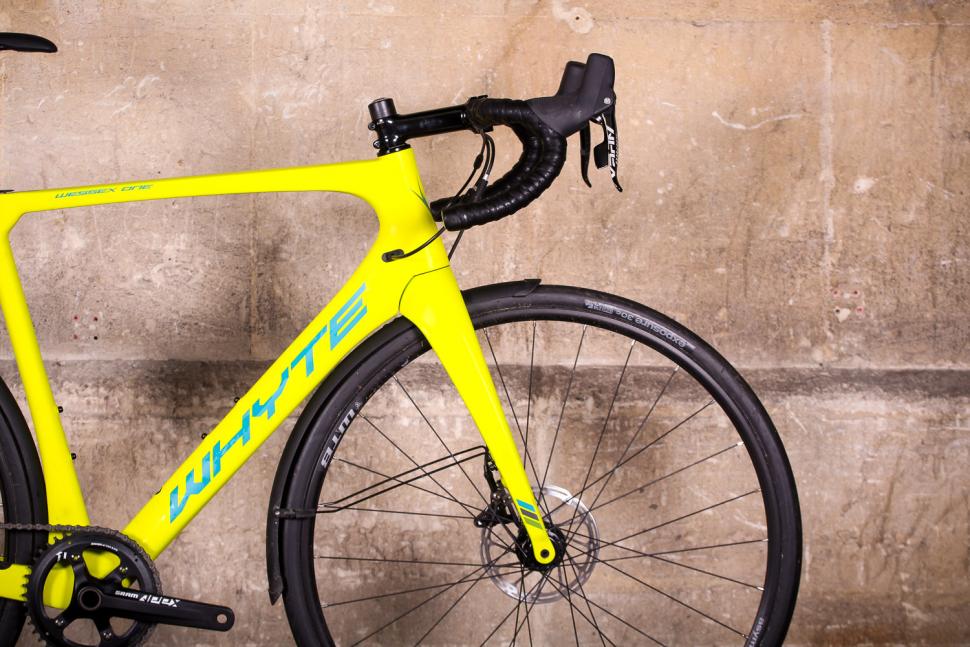
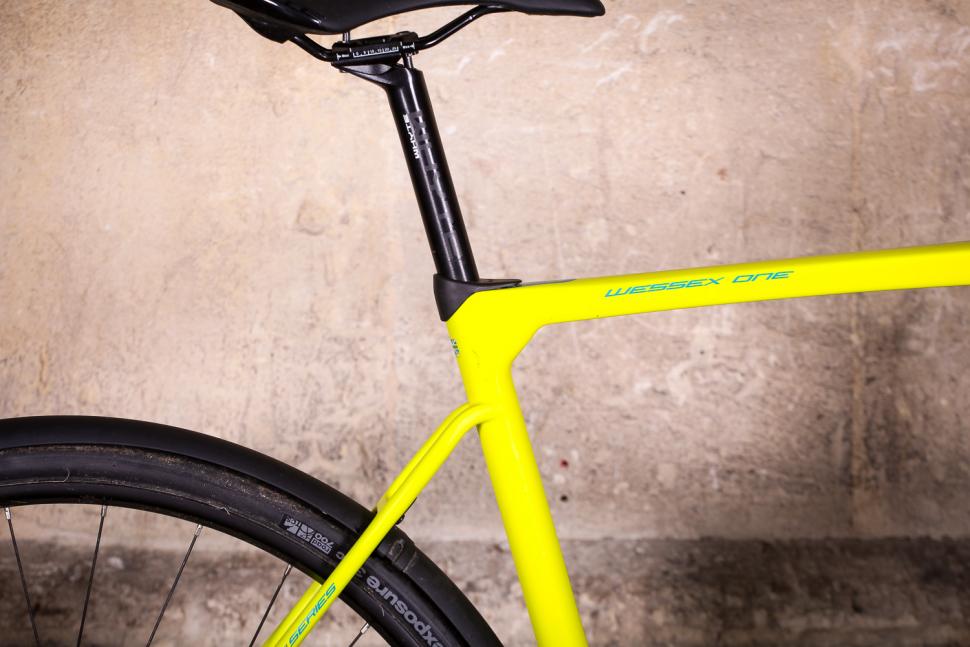


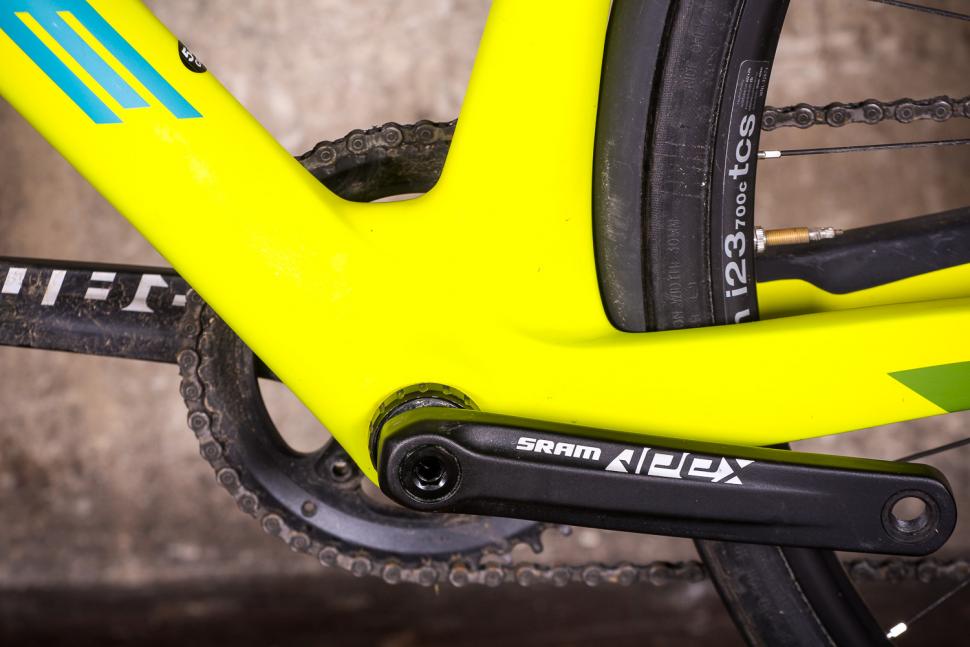
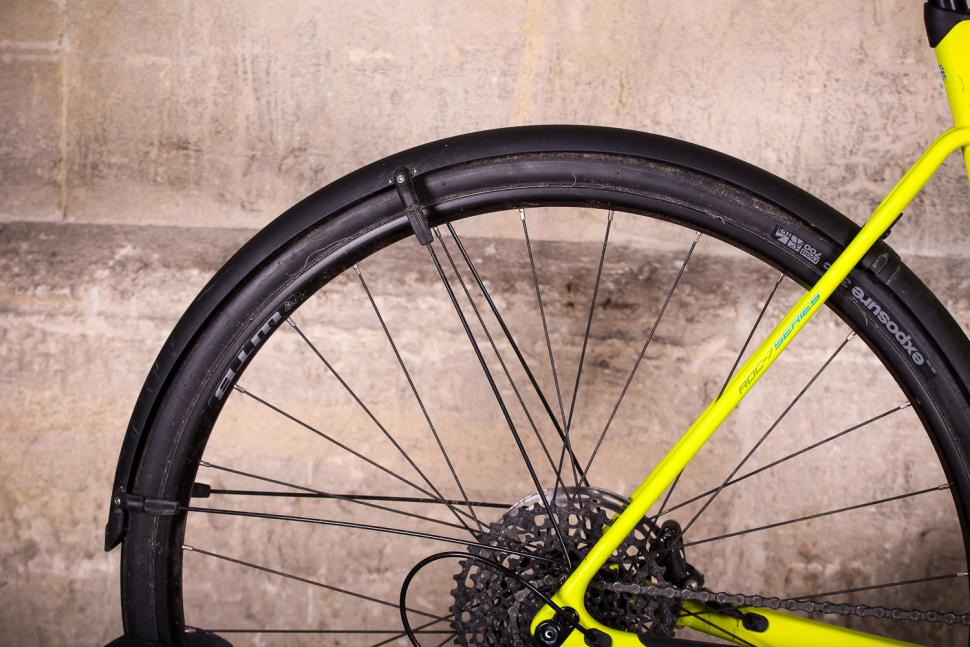


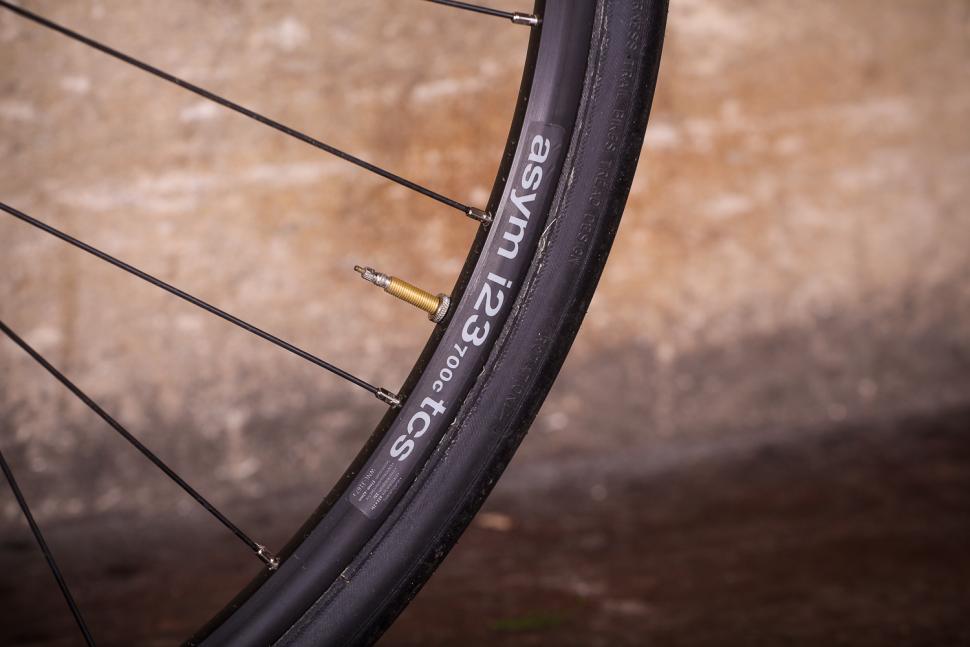




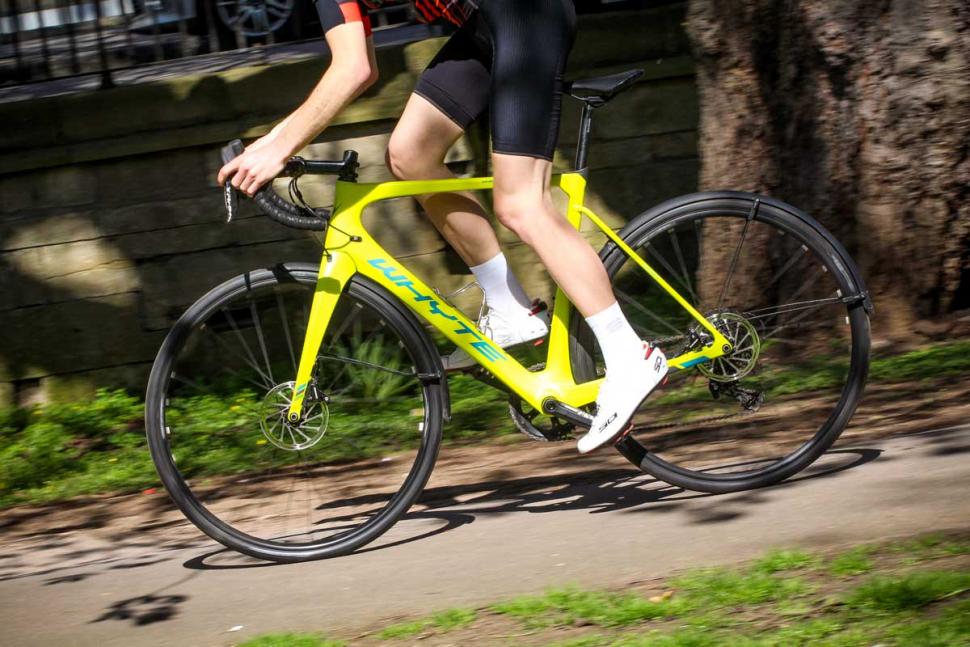
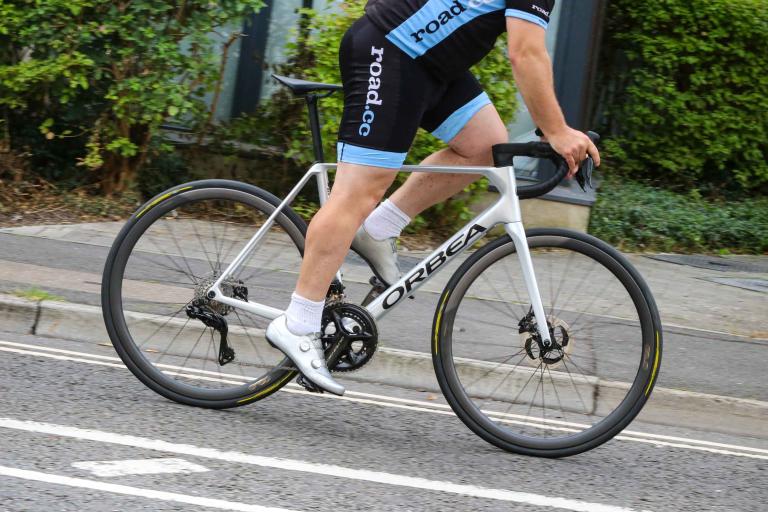

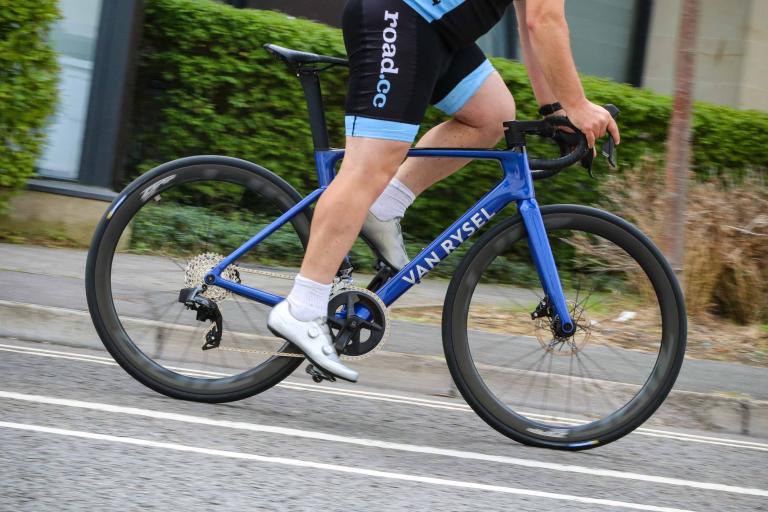
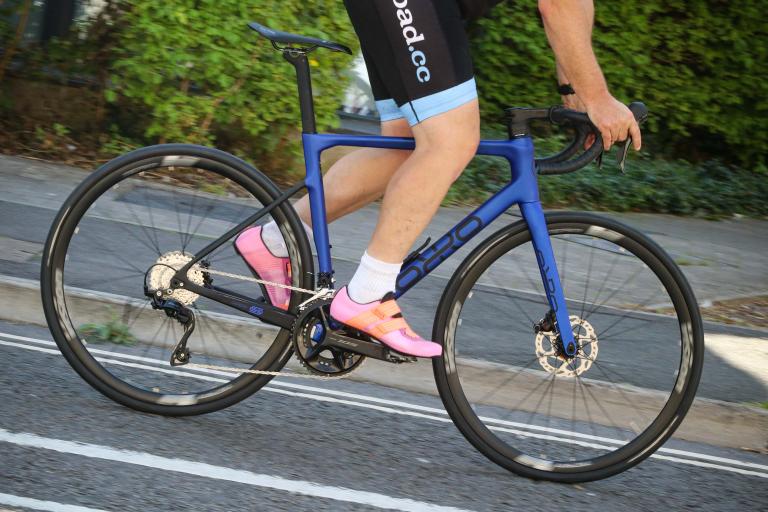
Add new comment
5 comments
Hmmm... fit road tyres and a closer range cassette and this could be fun (but a bit heavy - is it the wheels?).
Yes - stocks swapped for cosmics = happiness
Oh, look - another Whyte with utterly pointless mudguards. That front guard is going to coat your front mech (and feet) with spray, and I wouldn't fancy riding behind one either. Guards need to be flap-compatible or reach way past the 9 o'clock position to be truly winter-proof. Clearances don't look particularly road-muck friendly either.
Have ridden mine through two winters now and can confirm the clearances are fine with a fatter set of 700 x 30 bontragers fitted to soak up the commute lumps and bumps. Zero dramas
What front mech?